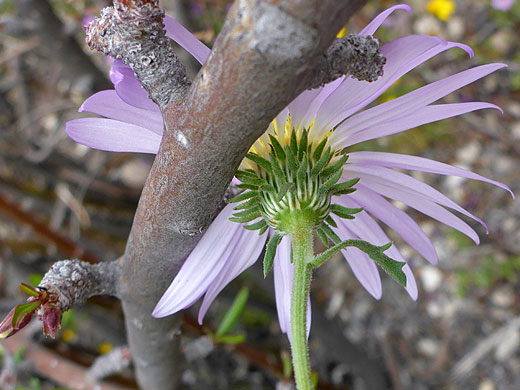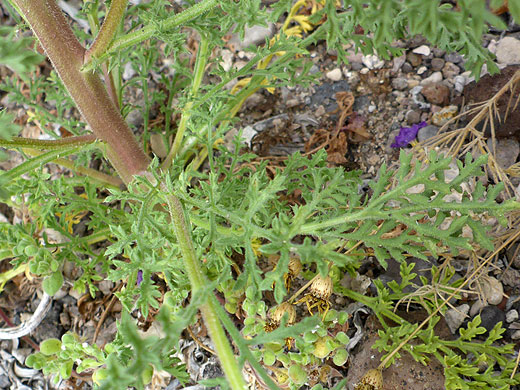Machaeranthera Tanacetifolia, Tansyleaf Aster
Plants > Wildflowers > Asteraceae > Machaeranthera Tanacetifolia

Purple and yellow flowerhead of machaeranthera tanacetifolia - Dome Trail, Big Bend Ranch State Park, Texas
Common names:
Tansyleaf aster, Tahoka daisy, prairie aster
Family:
Scientific name:
Machaeranthera tanacetifolia
Synonym:
Aster tanacetifolius
Main flower color:
Range:
The Rocky Mountains and adjacent areas, south to west Texas and southeast California
Height:
Up to 40 inches
Habitat:
Scrubland, grassland, woodland, disturbed areas; 2,700 to 8,200 feet
Leaves:
Up to 4 inches long and 1.5 inches across; pinnately divided 1 or 2 times
Season:
March to October
Flowerheads of machaeranthera tanacetifolia have a hemispheric involucre ringed by 3 to 6 rows of linear, pointed-tipped phyllaries, the longest about half an inch. Phyllaries (typically numbering 40 to 80) are spreading above the midpoint; angled outwards or curved backwards, and are mostly colored green apart the edges of the base which are whitish. Above the involucre are 12 to 40 purple ray florets (often white at the base) around a center of 18 to 160 yellow disc florets, which have no hairs on their corollas, unlike those of the similar machaeranthera tagetina. Rays are a little less than one inch long.
Stems and leaves do usually have a covering of hairs, and are often densely glandular. Plants produce several stems, branching at intervals to form bushy clumps. Leaves are pinnately divided into small, pointed lobes. Stems are purple around the base, green towards the top. Leaves grow at the base and all along the stems.
Stems and leaves do usually have a covering of hairs, and are often densely glandular. Plants produce several stems, branching at intervals to form bushy clumps. Leaves are pinnately divided into small, pointed lobes. Stems are purple around the base, green towards the top. Leaves grow at the base and all along the stems.
All Contents © Copyright The American Southwest | Comments and Questions | Contribute | Site Map






